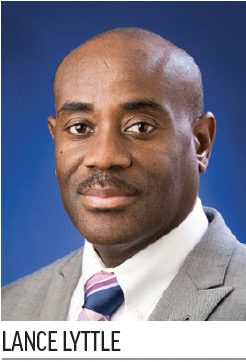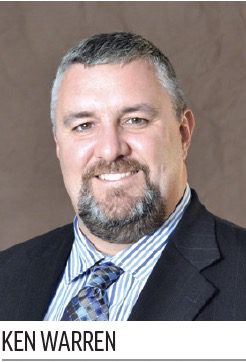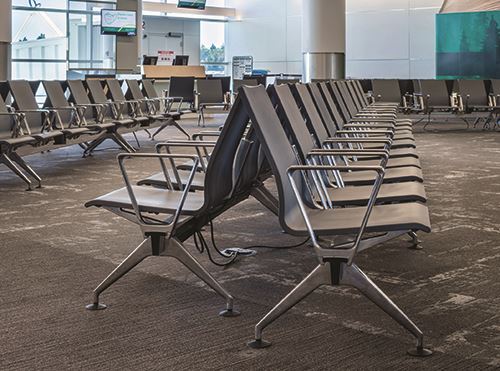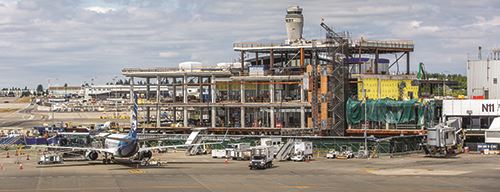This summer, just as passengers returned in significant numbers, Seattle-Tacoma International Airport (SEA) opened Phase 2 of its $710 million North Satellite modernization project, adding much-needed gates and square footage.
This summer, just as passengers returned in significant numbers, Seattle-Tacoma International Airport (SEA) opened Phase 2 of its $710 million North Satellite modernization project, adding much-needed gates and square footage.
 The investment, however, was about more than adding operating space. Making sure the new facilities meet or exceed passenger expectations was equally important for the Port of Seattle, which owns and operates SEA.
The investment, however, was about more than adding operating space. Making sure the new facilities meet or exceed passenger expectations was equally important for the Port of Seattle, which owns and operates SEA.
“We have some very ambitious long-term goals,” says SEA Managing Director Lance Lyttle. Among them is earning top marks in passenger satisfaction. For Lyttle, that means a five-star Skytrax rating and ranking in the top 25 for the worldwide Airport Service Quality awards—all by 2025. Within the next decade, the goal is to provide IATA’s Optimal level of service at all SEA facilities, even during peak travel times.
|
Project: North Satellite Modernization Location: Seattle-Tacoma Int’l Airport Cost: $710 million Funding: Airline fees; Airport Development Fund; passenger facility charges Timeline: Feb. 2017-July 2021 Labor: 2.1 million hours Construction: Hensel Phelps Designer: AECOM Structural Engineer: MKA Mechanical: Hermanson Electrical: Veca Passenger Loading Bridges: JBT AeroTech Holdroom Seating: Vitra, Open Square Aircraft Docking System: ADB SAFEGATE Baggage Handling System Design: Daifuku Baggage Handling System Controls: NORD Smoke Detection System: VESDA Systems |
Renovating aging facilities such as the North Satellite is just one way SEA plans to achieve its ambitious objectives. At nearly 50 years old, the facility was overdue for an upgrade.
The recently completed renovations were part of SEA’s capital development plan crafted in the early 2000s. Ken Warren, SEA’s capital program leader, notes that the North Satellite originally opened in 1973 and has only received minor facility upgrades since. The same is true for the South Satellite.
When SEA served 51.8 million passengers in 2019, lack of available gates became a major challenge. In fact, the eight new gates added to North Satellite were fully occupied by Alaska Airlines immediately upon opening. “There is a tremendous demand for travel in the Puget Sound region,” Lyttle explains. “Prior to the pandemic, we saw tremendous growth year over year, but didn’t have enough gates to accommodate the growth.”
Back in 2012, Alaska Airlines expressed an interest in expanding at SEA and establishing a home base out of the North Satellite. That prompted the airport to begin planning a renovation focused on four main objectives: technology upgrades, a seismic retrofit, improving the customer experience and creating a Pacific Northwest sense of place.
But in 2014, officials realized that demand was growing faster than they could renovate. That’s when plans for the North Satellite renovation changed to include an expansion as well. “So we took a pause for a year to figure out how we could expand without impacting other facilities and how many gates we could expand to,” Warren explains.
Between 2015 and 2017, planning and some preliminary shifting of airlines occurred to make room for expansion to the north. Ultimately, the North Satellite project added eight contact gate positions, for a new total of 20. It also provided 213,000 square feet of added and renovated space, more than doubling the facility footprint to 468,000 square feet.
After the expansion portion of the project opened in January 2019, Phase II began with construction of a new building directly over the old North Satellite. The original building was then demolished, and the new expansion was melded together to create a brand new facility that fully opened on June 29, 2021.
Customer Satisfaction Drives Design
Even before Lyttle came to SEA almost six years ago, airport leadership performed extensive surveys to determine what passengers want and need. “The customers themselves outlined the things they consider to be a priority,” Lyttle remarks, noting that restrooms always top the list. The diversity and volume of concessions is another perennial focus.
“We’re putting in these facilities from the feedback that we’ve gotten from our customers, but also for the standards that have been established by IATA’s Optimal level of service and Skytrax’s ratings,” says Lyttle.
Warren adds that improving the passenger experience was a key intention of the North Satellite program. “We call it the curb-to-seat experience,” he explains. “From the time you arrive at the airport and get over to the North Satellite, your stress level is going to be lower.”
Customers wanted to feel like they were outside even when inside the terminal, so designers included a vertical clerestory glass feature that allows sunlight to penetrate deep into the holdrooms. Wood tones, including columns painted to resemble trees in the forest, add to the outdoorsy feel. With ceiling tiles made of FSC-certified beechwood, the airport can assure patrons that the materials came from responsibly managed forests.
 The architectural concept designers developed for the terminal prioritized expansive views and intuitive wayfinding, and was dubbed “The River” accordingly. As passengers step off the escalator, they are directed into an open marketplace. From there, they are led through the meandering concourse, which curves in and out like a river. Along the way, there is space for travelers to congregate around various concessionaires and “islands” with kiosks and art installations. “It really does play with this Northwest sense of place and river concept,” Warren says.
The architectural concept designers developed for the terminal prioritized expansive views and intuitive wayfinding, and was dubbed “The River” accordingly. As passengers step off the escalator, they are directed into an open marketplace. From there, they are led through the meandering concourse, which curves in and out like a river. Along the way, there is space for travelers to congregate around various concessionaires and “islands” with kiosks and art installations. “It really does play with this Northwest sense of place and river concept,” Warren says.
Wayfinding in the new North Satellite is easier and more intuitive, says Frederick Robinson, a Port of Seattle project manager. “The openness and architectural features really do set your mind at ease,” he relates. “If you’re in The River, you can see the full length of the terminal, which gives you some confidence that you’re able to enjoy the full terminal, go to the shops, find your way around.”
Lyttle describes the mountain views from the new Marketplace N as nothing short of spectacular. (The space itself is nearly 80 feet tall.) In early September, specific concessions were still under construction, but the new lineup was designed to provide more diversity and high quality customer service. “It’s extremely important for us to meet that level of service,” Lyttle emphasizes.
“It was really a matter of this terminal trying to rise and meet the expectations of modern design for aviation and operability,” Robinson agrees. “And we think we did a great job.”
Reimagined Restrooms, Etc.
Lyttle is particularly proud that the North Satellite earned recognition as a finalist for the 2019 best restrooms (transportation category) from Cintas.
Designers specified closely spaced ceramic tiles with minimum grout for aesthetic appeal and easy maintenance. A water turbine-powered system recharges lithium ion batteries for the infrared faucets, saving SEA about $60,000 per year on batteries. Soap dispensers draw product from a common system to deliver a continuous supply.
In 2015, Warren challenged sink manufacturers to develop a multi-lavatory configuration with an impervious surface. “The industry responded with a wonderful white quartz, multi-bowl design that’s absolutely fantastic,” he reports. “It doesn’t splash our patrons, it’s easy to clean, and has that ‘opening day shine’ every day.”
The ventilation system is another standout feature. It changes the air in each restroom every six minutes—more than twice the minimum standard, Warren notes. Partitions are 32 inches wide, rather than the standard 24 inches; and shelves inside each stall mean passengers don’t have to juggle their belongings or search for a safe place to set them.
Responding to frequent requests from pet owners, SEA installed an animal relief area—equipped with artificial turf, a water station and even a simulated tree stump. A heavy-duty exhaust system and a stainless steel floor with drains help keep the space clean and comfortable.
Other enhancements for passengers include voice and visual paging, and a flight information display system that provides terminal-wide notifications as well as flight details.
The airport replaced all holdroom seating with new models from Vitra that include power ports—another highly requested amenity. Warren describes the terminal-wide WiFi coverage as the “latest and greatest,” noting that it allows airlines the flexibility and connectivity they need to operate effectively. “We’ve done a lot of things in coordination with our airline partners, as well as satisfying all the infrastructure needs of our airport,” he remarks.

Another change intended to resonate with the airlines was upgrading or replacing all 20 boarding bridges with equipment from JBT AeroTech. “They all have better safety features, are better able to be guided and used by the airlines,” says Robinson.
On the ramp, each gate position includes power, potable water and access to the hydrant fueling system. The airport installed LED fixtures on the facility exterior for aircraft parking, and the SafeDock system from ADB SAFEGATE to facilitate safer aircraft operations.
Environmentally Sound
Sustainability was a priority for the North Satellite renovation/expansion, and officials expect the structure to achieve LEED Silver Certification from the U.S. Green Building Council. Energy-efficient LED lighting and heating/cooling systems were selected to save approximately 1.7 million kWh annually. Renewable natural gas, a low-carbon alternative often produced from landfill waste, is used to heat the building. Using captured rainwater to flush toilets is expected to save 2.8 million gallons of potable water annually.
“You have to listen to passengers, the ultimate customers, and your business partners,” Lyttle remarks. “You have to design and build a facility to meet their needs; but you also have to understand that we have a responsibility to the community and the people who are going to be on this earth in the future. So as you do that expansion, you have to do it in a sustainable manner.”
To support the project’s environmental goals, designers kept as much as possible from the existing facility, including floors, columns and beams. In total, 76% of the construction waste—about 20,000 tons and nearly $21 million of recycled materials—was diverted from landfills and re-used.
The need for a seismic retrofit of the North Satellite was highlighted by a 2003 earthquake in the Puget Sound region. The structure was then expanded with one structural bay around the perimeter of the building and an addition on the north end. “We knew that the columns, beams and floor plates were all great materials that we could keep, but how do you meet the code?” Warren relates.
To do so, structural engineers from MKA analyzed the entire facility and devised a way to maintain the existing building and encompass it with the new terminal—giving it what they call a “seismic hug.”
“We are hugging that existing building by buttressing it all around the perimeter with the new expansion to keep it safe and sound from a seismic and structural perspective,” Warren explains. He estimates that MKA’s creative idea saved the Port $50 million while meeting its seismic and sustainability goals.
Upgrades to the baggage handling system also support SEA’s ongoing sustainability efforts. Variable frequency drives on the motors and control system save energy and money by stopping the system when no bags are present.
Similarly, escalators pause when not in use, saving about 30% in energy costs. A new building controls system and a Vesda smoke detection system further contribute to the airport’s sustainability goals, adds Warren.
“We’ve employed a lot of new technologies that make it a very smart building,” he says. “It’s something that’s very infrastructure-robust because we are building for the future.”

Integrated Art
Ten new pieces of museum-quality art adorn the renovated North Satellite, including SEA’s largest interior installation to date. Boundary, by renowned Seattle sculptor John Grade, is an artistic representation of a tree trunk and root system constructed from 8,000 pounds of Western Red Cedar. The piece measures 80 feet wide, more than 40 feet tall and extends more than 25 feet off of the wall of Marketplace N. It doesn’t portray tree branches, but implies to viewers that there is more to see above the roof.
“Art is built into the facility—it’s purpose-built for each art piece,” Warren advises. Many installations feature local and regional artists to reflect the diverse environment, culture, spirit, people and history of the Pacific Northwest.
The airport also included the performing arts by adding a space where visitors can watch live performances.

Sequencing for Success
Throughout construction, the North Satellite had to remain operational for main tenant Alaska Airlines. This proved to be “really complicated,” Warren notes, adding that the two-phase project included 22 micro-sequences. The project team focused on phasing work to keep a minimum number of gates, restrooms and passageways operational, while also meeting customer service goals and making sure contractors had enough space to work safely and efficiently.
 “There was a tremendous amount of temporary barricades, scaffolding and temporary corridors to protect passengers and get them to the gates that were in operation,” recalls Jason Coyne, general superintendent with general contractor
“There was a tremendous amount of temporary barricades, scaffolding and temporary corridors to protect passengers and get them to the gates that were in operation,” recalls Jason Coyne, general superintendent with general contractor
Hensel Phelps.
“We know time is money,” reflects Warren. “And we know the more we chop it up, the more time it takes and the more money it’s going to cost.
“I think we did a good job of trying to marry a customer service level standard and do the things we needed to do to transform this terminal into a facility that’s going to be the home of Alaska Airlines for the next 50 years.”
Robinson adds that SEA is a gate-constrained airport with a small footprint. “That’s why the sequencing and phasing were so incredibly important to the success of this project,” he explains.
For instance, construction crews had to work from scaffolding 61 feet above the concourse floor to install the ceiling in Marketplace N. Coyne notes that erecting 350-foot-long, 175,000-pound trusses over an operational terminal was a major challenge that took a lot of pre-planning and months of coordination.

 Scott Thomas, senior construction manager for the Port of Seattle, notes that switching over from the old facility entailed shutting down mechanical and electrical systems more than 2,000 times—another feat that required coordination to keep the building operational and passengers comfortable.
Scott Thomas, senior construction manager for the Port of Seattle, notes that switching over from the old facility entailed shutting down mechanical and electrical systems more than 2,000 times—another feat that required coordination to keep the building operational and passengers comfortable.
To ease the transition, the airport created an Operational Readiness Activation and Transfer (ORAT) Department. Robinson describes its role as bridging the divide between the end of construction and the beginning of operations in the new facility. Employees who will operate in and around the new facility need an understanding of how things work there, he explains. Additionally, the ORAT team test-drives systems and updates all standard operating procedure documents so that fire and police departments know how to respond to emergencies at the new North Satellite.
Working Amid COVID
When the coronavirus pandemic began, SEA’s North Satellite project was deemed essential and construction continued with layers of extra precautions. As passenger traffic declined, the project team worked together to combine steps and managed to shave nearly three months off of the overall schedule.

“Instead of getting stuck with lemons, we made lemonade by closing part of the terminal and saving a tremendous amount of time and providing Hensel Phelps with more work area so they could get their work done,” Warren recalls. “During a time when everyone was nervous and scared about what was happening, Hensel Phelps worked with the construction team to make everybody feel comfortable and safe.”
For example, separate break spaces were created outside on the tarmac; teams grouped together to provide redundancy if someone got sick; and smaller buses were used to transport workers to and from the jobsite.
As passengers enjoy the new facility and traffic rebounds, Lyttle reports that SEA is still short on gates, but the North Satellite modernization is a dramatic shift from the 1970s to a modern-day customer experience.


 facts&figures
facts&figures

